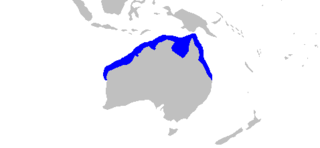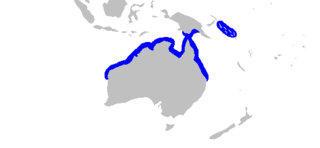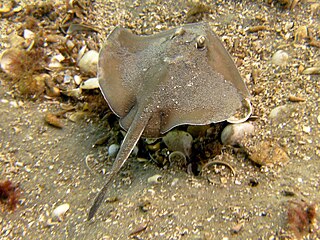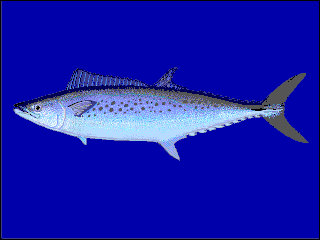
Daphnia is a genus of small planktonic crustaceans, 0.2–5.0 mm (0.01–0.20 in) in length. Daphnia are members of the order Cladocera, and are one of the several small aquatic crustaceans commonly called water fleas because their saltatory (Wiktionary) swimming style resembles the movements of fleas. Daphnia spp. live in various aquatic environments ranging from acidic swamps to freshwater lakes and ponds.

Jasus edwardsii, the southern rock lobster, red rock lobster, or spiny rock lobster, is a species of spiny lobster found throughout coastal waters of southern Australia and New Zealand including the Chatham Islands. This species is commonly called crayfish or crays in both Australia and New Zealand and kōura in Māori. They resemble lobsters, but lack the large characteristic pincers on the first pair of walking legs.

The creek whaler is a common species of requiem shark, and part of the family Carcharhinidae, endemic to northern Australia. It frequents shallow waters close to shore, including estuaries. This small, stocky shark usually grows to 1.0–1.3 m (3.3–4.3 ft) long and is brownish in color without conspicuous fin markings. It can be identified by its long snout, large, triangular pectoral fins, and large, anteriorly positioned first dorsal fin.

The nervous shark is a species of requiem shark, and part of the family Carcharhinidae, so named because of its timid behavior in regard to humans. It is common in shallow, coastal waters off northern Australia, Papua New Guinea, and the Solomon Islands. A small brownish or grayish shark typically measuring 1.0–1.3 m (3.3–4.3 ft) long, this species has a short, blunt snout, oval eyes, and a relatively large second dorsal fin. The leading margins of most fins are finely edged with black, and the lower caudal fin lobe is black-tipped.

The spot-tail shark, or sorrah shark, is a species of requiem shark, in the family Carcharhinidae, found in the tropical Indo-West Pacific Ocean between latitudes 31°N and 31°S, from the surface to a depth around 72 m (236 ft). This shark grows to about 1.6 m. It is fished commercially over much of its range and the IUCN considers it to be near threatened.

The Australian blacktip shark is a species of requiem shark, in the family Carcharhinidae, endemic to northern and eastern Australia. Favoring the upper and middle parts of the water column, it can be found from the intertidal zone to a depth of 50 m (160 ft). Appearance-wise this species is virtually identical to the common blacktip shark, from which it can be reliably distinguished only by its lower vertebra number and by genetic markers. Generally reaching 1.5–1.8 m (4.9–5.9 ft) in length, it is a fairly stout-bodied, bronze-colored shark with a long snout and black-tipped fins.

The ornate angelshark is an angelshark of the family Squatinidae endemic to southern Australia between latitudes 30°S and 35°S, at depths of 130–400 m (430–1,310 ft). It can reach lengths of up to 1.4 m (4.6 ft). Females tend to have a TL at 1150–1250 mm, while males range from a TL of 810–910 mm at sexual maturity. Reproduction is ovoviviparous, with two to nine pups per litter.

The spotted tilapia, also known as the spotted mangrove cichlid or black mangrove cichlid, is a species of fish of the cichlid family. It is native to fresh and brackish water in West and Central Africa, but has been introduced to other regions where it is considered invasive.

The sparsely-spotted stingaree, also known as the white-spotted stingaree or Dixon's stingaree, is a species of stingray in the family Urolophidae, common off the southern Australian coast. Preferring sandy flats and seagrass beds, this benthic ray can be found from close to shore to a depth of at least 150 m (490 ft), and tends to occur deeper in the northern portion of its range. Reaching a length of 57 cm (22 in), this species has a broad, diamond-shaped pectoral fin disc that is typically plain gray in color above with a V-shaped marking between the eyes. Individuals from southerly waters also generally exhibit a smattering of small, dark-edged white spots. This ray is further characterized by a distinctively bell-shaped curtain of skin between the nostrils. Its tail has a skin fold running along either side and a leaf-shaped caudal fin, but no dorsal fin.

The blind cave eel is a species of fish in the family Synbranchidae. It is endemic to subterranean waters in the coastal Pilbara region and Barrow Island. Like other cavefish such as Milyeringa, the blind cave eel is entirely blind and lacks pigmentation. It is listed as vulnerable under the Australian Environment Protection and Biodiversity Conservation Act 1999. Reaching a length of 40 cm (16 in), it is the longest known cavefish.
Calamoecia is a genus of copepods in the family Centropagidae confined to Australasia. It is thought to have evolved since the separation of the Australian continent from Antarctica. Three of the Australian endemic species are listed as vulnerable species on the IUCN Red List. The genus contains the following species:
Daphnia jollyi is a species of crustaceans in the genus Daphnia. It is endemic to Western Australia, where it lives in shallow freshwater pools over granite bedrock. Daphnia jollyi is listed as a vulnerable species on the IUCN Red List.
Daphnia occidentalis is a species of crustacean in the family Daphniidae. It is endemic to Australia, and is the only species in the subgenus Australodaphnia.
Hemiboeckella powellensis is a species of copepod endemic to Lake Powell, Western Australia. It is listed as a vulnerable species on the IUCN Red List. It was first described by I. A. E. Bayly in 1979. No females have been found.

Daphniidae is a family of water fleas in the suborder Anomopoda.

The Australian spotted mackerel is a species of fish in the family Scombridae. Common fork length ranges between 50 and 80 cm. Specimens have been recorded at up to 104 cm in length, and weighing up to 10.2 kg. It is found in the western Pacific, along the northern coast of Australia, from the Abrolhos Islands region of Western Australia to Coffs Harbour and Kempsey in central New South Wales. It is also found in southern Papua New Guinea from Kerema to Port Moresby. It feeds largely on fishes, particularly anchovies and sardines, with smaller quantities of shrimps and squids. It is sometimes confused with Japanese Spanish mackerel, S. niphonius. Conservation status of the species has been evaluated as Near Threatened by the IUCN. This species was described in 1980 and was previously confused with the Japanese Spanish mackerel of the north western Pacific but S. munroi has a different visceral structure, more vertebrae and fewer gill rakers.
Daphnia lumholtzi is a species of small, invasive water fleas that originates in the tropical and subtropical lakes of Africa, Asia, and Australia. As an invasive species, Daphnia lumholtzi disrupts aquatic habitats by spreading throughout the warmer waters of lakes and reservoirs.

The Pacific blue-eye is a species of fish in the subfamily Pseudomugilinae native to eastern Australia. Described by Austrian naturalist Rudolf Kner in 1866, it comprises two subspecies that have been regarded as separate species in the past and may be once again with further study. It is a common fish of rivers and estuaries along the eastern seaboard from Cape York in North Queensland to southern New South Wales, the Burdekin Gap in central-north Queensland dividing the ranges of the two subspecies.

Panulirus longipes, the longlegged spiny lobster, is a species of spiny lobster that lives on shallow rocky and coral reefs in the tropical Indo-Pacific region. The International Union for Conservation of Nature has assessed its conservation status as being of "least concern".

Daphnia longispina is a planktonic crustacean of the family Daphniidae, a cladoceran freshwater water flea. It is native to Eurasia. D. longispina is similar in size and sometimes confused with the often sympatric D. pulex, but much smaller than D. magna. D. longispina is found in a wide range of standing freshwater bodies from small, ephemeral rock-pools to large lakes.














